NCERT Solutions Class 10 Maths
Chapter – 13 (Surface Areas and Volumes)
The NCERT Solutions in English Language for Class 10 Mathematics Chapter – 13 Surface Areas and Volumes Exercise 13.1 has been provided here to help the students in solving the questions from this exercise.
Chapter : 13 Surface Areas and Volumes
- NCERT Class 10 Maths Solution Ex – 13.2
- NCERT Class 10 Maths Solution Ex – 13.3
- NCERT Class 10 Maths Solution Ex – 13.4
- NCERT Class 10 Maths Solution Ex – 13.5
Exercise – 13.1
Unless stated otherwise, take π = 22/7
1. 2 cubes each of volume 64 cm3 are joined end to end. Find the surface area of the resulting cuboid.
Solution – The diagram is given as:
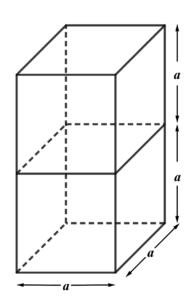
Given-
The Volume (V) of each cube is = 64 cm3
This implies that a3 = 64 cm3
∴ a = 4 cm
Now, the side of the cube = a = 4 cm
Also, the length and breadth of the resulting cuboid will be 4 cm each, while its height will be 8 cm.
So, the surface area of the cuboid = 2(lb+bh+lh)
= 2(8 × 4 + 4 × 4 + 4 × 8) cm2
= 2(32 + 16 + 32) cm2
= (2 × 80) cm2
= 160 cm2
2. A vessel is in the form of a hollow hemisphere mounted by a hollow cylinder. The diameter of the hemisphere is 14 cm, and the total height of the vessel is 13 cm. Find the inner surface area of the vessel.
Solution – The diagram is as follows:
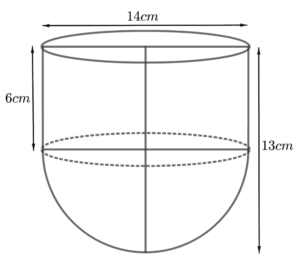
Now, the given parameters are:
The diameter of the hemisphere = D = 14 cm
The radius of the hemisphere = r = 7 cm
Also, the height of the cylinder = h = (13 – 7) = 6 cm
And the radius of the hollow hemisphere = 7 cm
Now, the inner surface area of the vessel = CSA of the cylindrical part + CSA of the hemispherical part
(2πrh + 2πr2) cm2
= 2πr(h + r) cm2
= 2 × (22/7) × 7(6 + 7) cm2
= 572 cm2
3. A toy is in the form of a cone of radius 3.5 cm mounted on a hemisphere of the same radius. The total height of the toy is 15.5 cm. Find the total surface area of the toy.
Solution – The diagram is as follows:
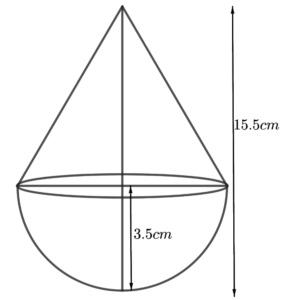
Given that the radius of the cone and the hemisphere (r) = 3.5 cm = 7/2 cm
The total height of the toy is given as 15.5 cm.
So, the height of the cone (h) = 15.5-3.5 = 12 cm
Slant height of the cone, l = √(r2 + h2)
l = √[(3.5 cm)2 + (12 cm)2]
l = √[12.25 cm2 + 144 cm2]
l = √ 56.25 cm2
l = 12.5 cm
l = 25/2 cm
∴ The curved surface area of the cone = πrl
= (22/7) × (7/2) × (25/2)
= 275/2 cm2
Also, the curved surface area of the hemisphere = 2πr2
= 2 × (22/7) × (7/2)2
= 77 cm2
Now, the Total surface area of the toy = CSA of the cone + CSA of the hemisphere
= (275/2) + 77 cm2
= (275 + 154)/2 cm2
= 429/2 cm2 = 214.5cm2
So, the total surface area (TSA) of the toy is 214.5cm2
4. A cubical block of side 7 cm is surmounted by a hemisphere. What is the greatest diameter the hemisphere can have? Find the surface area of the solid.
Solution – It is given that each side of the cube is 7 cm. So, the radius will be 7/2 cm.
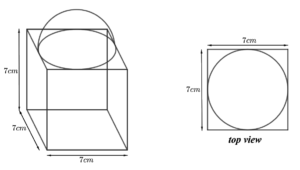
The total surface area of solid (TSA) = surface area of the cubical block + CSA of the hemisphere – Area of the base of the hemisphere
∴ TSA of solid = 6 × (side)2 + 2πr2 – πr2
= 6 × (side)2 + πr2
= 6 × (7)2 + (22/7) × (7/2) × (7/2)
= (6 × 49) + (77/2)
= 294 + 38.5
= 332.5 cm2
So, the surface area of the solid is 332.5 cm2
5. A hemispherical depression is cut out from one face of a cubical wooden block such that the diameter l of the hemisphere is equal to the edge of the cube. Determine the surface area of the remaining solid.
Solution – The diagram is as follows:
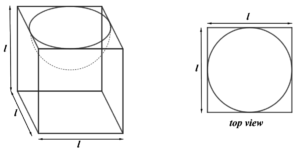
Now, the diameter of the hemisphere = Edge of the cube = l
So, the radius of the hemisphere = l/2
∴ The total surface area of solid = surface area of cube + CSA of the hemisphere – Area of the base of the hemisphere
The surface area of the remaining solid = 6 (edge)2 + 2πr2 – πr2
= 6l2 + πr2
= 6l2 + π(l/2)2
= 6l2 + πl2/4
= l2/4(24 + π) sq. units
6. A medicine capsule is in the shape of a cylinder with two hemispheres stuck to each of its ends. The length of the entire capsule is 14 mm, and the diameter of the capsule is 5 mm. Find its surface area.
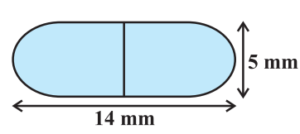
Solution – Two hemispheres and one cylinder are shown in the figure given below.
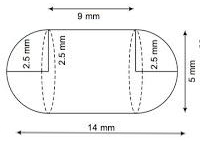
Here, the diameter of the capsule = 5 mm
∴ Radius = 5/2 = 2.5 mm
Now, the length of the capsule = 14 mm
So, the length of the cylinder = 14 – (2.5 + 2.5) = 9 mm
∴ The surface area of a hemisphere = 2πr2
= 2 × (22/7) × 2.5 × 2.5
= 275/7 mm2
Now, the surface area of the cylinder = 2πrh
= 2 × (22/7) × 2.5 × 9
= (22/7) × 45
= 990/7 mm2
Thus, the required surface area of the medicine capsule will be = 2 × surface area of hemisphere + surface area of the cylinder
= (2 × 275/7) × 990/7
= (550/7) + (990/7)
= 1540/7
= 220 mm2
7. A tent is in the shape of a cylinder surmounted by a conical top. If the height and diameter of the cylindrical part are 2.1 m and 4 m, respectively, and the slant height of the top is 2.8 m, find the area of the canvas used for making the tent. Also, find the cost of the canvas of the tent at the rate of Rs 500 per m2. (Note that the base of the tent will not be covered with canvas.)
Solution – It is known that a tent is a combination of a cylinder and a cone.
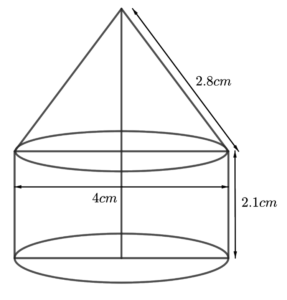
Diameter = 4 m
The slant height of the cone (l) = 2.8 m
Radius of the cone (r) = Radius of cylinder = 4/2 = 2 m
Height of the cylinder (h) = 2.1 m
So, the required surface area of the tent = surface area of the cone + surface area of the cylinder
= πrl + 2πrh
= πr(l + 2h)
= (22/7) × 2(2.8 + 2 × 2.1)
= (44/7)(2.8 + 4.2)
= (44/7) × 7
= 44 m2
∴ The cost of the canvas of the tent at the rate of ₹500 per m2 will be
= Surface area × cost per m2
= 44 × 500
= ₹22000
So, Rs. 22000 will be the total cost of the canvas.
8. From a solid cylinder whose height is 2.4 cm and diameter is 1.4 cm, a conical cavity of the same height and same diameter is hollowed out. Find the total surface area of the remaining solid to the nearest cm2.
Solution – The diagram for the question is as follows:
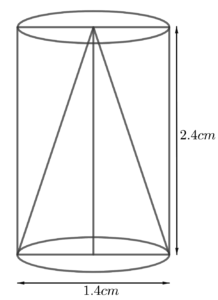
From the question, we know the following:
The diameter of the cylinder = diameter of conical cavity = 1.4 cm
So, the radius of the cylinder = radius of the conical cavity = 1.4/2 = 0.7
Also, the height of the cylinder = height of the conical cavity = 2.4 cm
Slant height of the cone, l = √[r2 + h2]
l = √[(0.7 cm)2 + (2.4 cm)2]
= √[0.49 cm2 + 5.76 cm2]
= √[6.25 cm2]
= 2.5 cm
Now, the TSA of the remaining solid = surface area of conical cavity + TSA of the cylinder
= πrl + (2πrh + πr2)
= πr(l + 2h + r)
= (22/7) × 0.7(2.5 + 4.8 + 0.7)
= 2.2 × 8
= 17.6 cm2
So, the total surface area of the remaining solid is 17.6 cm2
9. A wooden article was made by scooping out a hemisphere from each end of a solid cylinder, as shown in Fig. 13.11. If the height of the cylinder is 10 cm, and its base is of radius 3.5 cm, find the total surface area of the article.
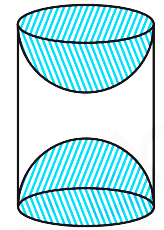
Solution – Radius (r) of cylindrical part = Radius (r) of hemispherical part = 3.5 cm
Height of cylindrical part (h) = 10 cm
TSA of the article = 2 × CSA of the hemispherical part + CSA of the cylindrical part
= 2 × 2πr2 + 2πrh
= 2πr (2r + h)
= 2 × 22/7 × 3.5 cm × (2 × 3.5 cm + 10 cm)
= 22 cm × 17 cm
= 374 cm2
Thus, the total surface area of the article is 374 cm2.

Leave a Reply